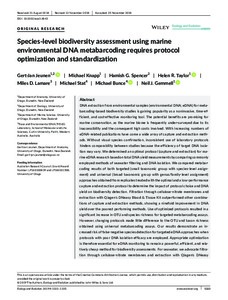Species‐level biodiversity assessment using marine environmental DNA metabarcoding requires protocol optimization and standardization.

View/
Average rating
votes
Date
2019Author
Jeunen, Gert‐Jan
Knapp, Michael
Spencer, Hamish G.
Taylor, Helen R.
Lamare, Miles D.
Stat, Michael
Bunce, Michael
Gemmell, Neil J.
Metadata
Show full item recordAbstract
DNA extraction from environmental samples (environmental DNA; eDNA) for metabarcoding‐based biodiversity studies is gaining popularity as a noninvasive, time‐efficient, and cost‐effective monitoring tool. The potential benefits are promising for
marine conservation, as the marine biome is frequently under‐surveyed due to its
inaccessibility and the consequent high costs involved. With increasing numbers of
eDNA‐related publications have come a wide array of capture and extraction methods. Without visual species confirmation, inconsistent use of laboratory protocols
hinders comparability between studies because the efficiency of target DNA isolation may vary. We determined an optimal protocol (capture and extraction) for marine eDNA research based on total DNA yield measurements by comparing commonly
employed methods of seawater filtering and DNA isolation. We compared metabarcoding results of both targeted (small taxonomic group with species‐level assignment) and universal (broad .....
Journal
Ecology and EvolutionVolume
9Page Range
pp.1323–1335Document Language
enSustainable Development Goals (SDG)
14.ABest Practice Type
Manual (incl. handbook, guide, cookbook etc)DOI Original
https://doi.org/10.1002/ece3.4843Citation
Jeunen, G‐J.; Knapp, M.; Spencer, H.G.; et al. (2019) Species‐level biodiversity assessment using marine environmental DNA metabarcoding requires protocol optimization and standardization. Ecology and Evolution, 9, pp.1323-1335. DOI:. https://doi.org/10.1002/ece3.4843Collections
The following license files are associated with this item:
 Repository of community practices in Ocean Research, Applications and Data/Information Management
Repository of community practices in Ocean Research, Applications and Data/Information Management
